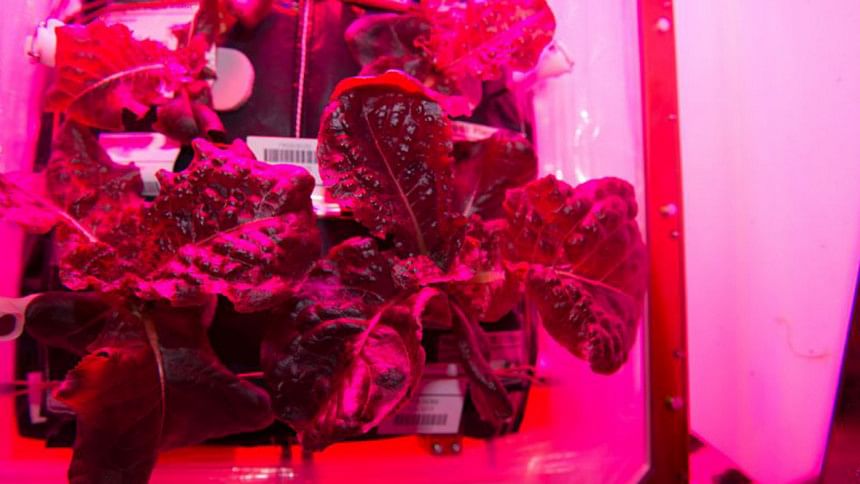NASA astronauts eat food grown in space for first time

NASA astronauts have eaten food grown in space for the first time in history, reports Vox.com.
The astronauts sampled red romaine lettuce, aboard the International Space Station, as part of NASA's VEG-01 experiment (nicknamed "VEGGIE"), reports Vox.com.
The lettuce had been growing in a specially designed chamber since early July, under the care of astronaut Scott Kelly.
After Kjell Lindgren carefully cleaned the greens with sanitizing wipes to ensure they were clean, the duo and Japanese astronaut Kimiya Yui first tasted them around 12:45 ET on Monday — before trying them again with a bit of olive oil and balsamic vinegar, reports Vox.com.
Vox.com reports, the astronauts only get to eat half the lettuce; the other half will be frozen and sent back to Earth for scientific analysis. Long term, the goal of this sort of microgravity gardening is to add a bit of variety and nutrition to astronauts' heavily processed, thermostabilized diets — something that could be especially important for the multiyear journey it'd take to send people to Mars.
"The astronauts have a pretty amazing diet, with a lot of different foods," Gioia Massa, NASA's lead researcher on the project, told me last year, "but they don't get fresh vegetables often."
How to grow produce in orbit?
Plants have been growing in space for a while now. The USSR put plant seeds (along with a mannequin and a dog named Chernushka) on one of its early Sputnik spacecraft, and plants were first germinated in orbit in 1997, when turnips sprouted about the old Mir space station.
According to Vox.com, in addition to two existing plant experiments already on board the International Space Station, astronaut Don Pettit grew a zucchini plant in a plastic bag for fun last year.
What's new about VEGGIE is that its goal is practical: providing food for astronauts. Using lessons learned from the previous experiments about how plants grow in zero gravity, engineers from the private company Orbitec worked with NASA to develop the new foot-wide growth chamber, reports Vox.com.
"Getting the environment exactly right for plants to grow in space is a challenge," Massa said. The chamber includes bright red, blue, and green LEDs (which are externally cooled to prevent the plants from overheating) and clear, flexible walls to trap humidity inside.
At the bottom of VEGGIE is a mat — for the plants' roots to take hold in — with six small Kevlar-lined plant "pillows" on top of it. Each of the pillows contains seeds, controlled-release fertilizer pellets, and a kitty litter–like clay mixture, designed to allow oxygen and water to reach the plants' roots as they grow.
"Watering is the biggest challenge," Massa said. "You've probably seen videos of water in space: It just forms a ball." As a solution, VEGGIE relies on a system in which water is injected directly into the pillows, stimulating germination.
Astronauts have grown lettuce and flowers so far
As an initial test, NASA picked the "Outredgeous" variety of red romaine lettuce because it's a relatively hardy, compact, and nutritious plant (and perhaps because it's delicious served with "its sweet crispy heart lightly kissed with a seasoned olive oil," according to its seed company).
In the first round of the experiment last summer, overseen by astronaut Steve Swanson, the system worked nicely, producing a number of hardy plants that grew at rates similar to those in a parallel comparison experiment at NASA's facility in Florida. Swanson also grew pillows of zinnia flowers for recreational purposes.
To avoid any risk of food poisoning, all the plants were sent back to Earth in September 2014 for thorough testing. This round, though, after 33 days of robust growth, NASA authorized Kelly and the other astronauts to actually eat the romaine.
Why NASA wants to grow vegetables in space?
Over the decades, NASA has optimized packaged space food. But there's only so much you can do with dehydrated or freeze-dried dishes — and astronauts are constantly asking for more fresh produce. "When they do get supply shipments up there, they eat all the vegetables right away," Massa said.
If VEGGIE is successful, it could be a relatively easy way of adding some freshness and variety to the space diet. It doesn't hurt that plants consume carbon dioxide and produce oxygen, which could help slightly to recycle the station's atmosphere. And astronauts have reported that the simple activity of caring for plants and watching them grow has added a bit of joy to their daily routine.
Currently, there are proposals in the works to grow a variety of different plants inside the chamber, which will stay on the station permanently. Like lettuce, the next ones will be things like herbs, greens, tomatoes, radishes, and snap peas that can just be picked and eaten. (Food staples that are usually eaten more processed, like grains, will have to wait until later.)
But there are longer-term motivations for the project, as well. If we wanted to send people to more distant space destinations, like Mars, enabling them to grow their own food would be essential.
"As we go farther and farther from Earth, it costs a lot to take food," Massa said. Currently, it takes about $10,000 to send a pound of food to the space station, a number that will only increase as our spacecraft travel further.
For her, the solution is obvious: "Ultimately, if we ever want to live somewhere else, we'll have to learn how we can produce food in those habitats."

 For all latest news, follow The Daily Star's Google News channel.
For all latest news, follow The Daily Star's Google News channel. 



Comments